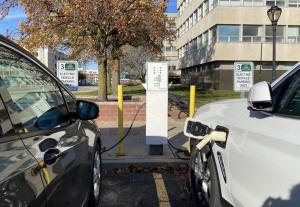1 million EVs: Inside the state’s plan for electrifying the
transportation sector
 Send a link to a friend
Send a link to a friend
[November 24, 2021]
By JERRY NOWICKI
Capitol News Illinois
jnowicki@capitolnewsillinois.com
 SPRINGFIELD – With a pair of major policy
victories in hand, Gov. JB Pritzker traveled to the United Nations
Climate Change Conference in Glasgow, Scotland, at the beginning of the
month and shared a vision for his home state: “Illinois intends to
become the best place in North America to drive and manufacture an
electric vehicle.” SPRINGFIELD – With a pair of major policy
victories in hand, Gov. JB Pritzker traveled to the United Nations
Climate Change Conference in Glasgow, Scotland, at the beginning of the
month and shared a vision for his home state: “Illinois intends to
become the best place in North America to drive and manufacture an
electric vehicle.”
It’s a message he’s repeated on countless occasions in recent public
appearances, and one that he brought to international business leaders
in a trip to London prior to the U.N. conference. And it’s one that, if
realized, the governor believes can yield victories for his
administration on a pair of his campaign cornerstones – economic growth
and carbon reduction.
“This is about economic development as much as it is about saving our
planet,” Pritzker said during a panel discussion at the U.N. conference
with governors from Washington, Oregon and Hawaii.
Numerically, that vision amounts to putting 1 million EVs on state roads
by 2030, a goal written into the Climate and Equitable Jobs Act, or CEJA,
a wide-ranging decarbonization bill that Pritzker signed into law in
September.

But how can Illinois increase the number of EVs on state roads to 1
million from just the 34,363 licensed in the state as of the end of
October?
For the Pritzker administration, CEJA and an EV manufacturing tax credit
package known as the REV Act make up the backbone of a push to lure
private investment while breaking down well-documented consumer barriers
to EV adoption as the industry stands on the cusp of an explosion.
“We have sent a very clear market signal not just in the United States,
but now across the world, that this is going to be the place if you want
to make, manufacture or drive an electric vehicle, to do it,” Deputy
Gov. Christian Mitchell, who accompanied Pritzker on his European trip,
said in a phone call.
With the new laws passed, the focus turns to implementation and
distributing more than $200 million in state and federal funding for the
rollout of charging infrastructure.
Mitchell and other advocates behind CEJA recently spoke to Capitol News
Illinois about the next step for meeting EV rollout goals, the strengths
of the two laws that aim to get Illinois there, and other actions the
administration has taken.
‘Jobs, jobs, jobs’
The key to Illinois’ approach to penetrating the EV market, Mitchell
said, is that it addresses the supply and demand sides of the industry.
“It's incredibly important if we are going to be successful as a state
and environmentalists are to be successful across the country, that we
couch this issue in jobs, jobs, jobs,” Mitchell said.
On the supply side, CEJA includes credits of up to 80 percent for the
installation of charging infrastructure. Money for that will come from a
$70 million allotment from the state’s 2019 Rebuild Illinois
infrastructure plan. Another $149 million sent to Illinois from a
recently-passed federal infrastructure plan will also aid in the
buildout.

On the demand side, CEJA includes a $4,000 rebate for those who buy
electric vehicles in the state. The governor’s office said there’s about
$5.1 million in the fund that will supply those rebates beginning in
July 2022, and as of now it has only a “rough estimate” that “thousands”
of Illinoisans will be able to receive the rebate.
For companies like EVgo, one of the largest public charging networks in
the U.S., policies like CEJA serve as a market catalyst, said Sara
Rafalson, vice president of market development and public policy at the
company.
“The most important thing that came out of the legislation at the state
level, is that Illinois is really poised for success, because we have in
place now both the complementary policies to support vehicle sales as
well as sustained long-term investments in charging infrastructure,” she
said. “For a business like ours, when we see higher vehicle sales, that
sends a strong signal to the market that we need to build more
chargers.”
The REV Act, which passed with near-unanimous bipartisan support in the
fall session, creates payroll tax credits ranging from 25 percent to 100
percent of income tax withheld for new or retained EV manufacturing
jobs, depending on factors such as company location and number of
employees hired. It also creates a 10 percent credit for training
expenses and credits for construction wages and building materials.
That measure also provides the incentives to manufacturers of electric
vehicle parts, such as batteries.
At a bill signing event for the REV Act, Jim Chen, vice president of
public policy of Rivian Automotive, which has an EV manufacturing plant
in the Bloomington-Normal area, said the bill will be a major support
for the company that already employs more than 3,000 Illinoisans in its
3.5 million square feet of manufacturing space.
“Today's bill signing represents the next step in promoting Illinois as
the Silicon Valley of EVs, as we work together to attract new investment
from suppliers and other supporting players in this industry,” he said.
The REV Act is also an effort to lure new manufacturers here while
encouraging existing companies, such as the Stellantis manufacturing
company in the Rockford area, to retool their existing plants.

“The fact that the governor was able to go to Glasgow, not just with a
climate bill in hand that provides a $4,000 incentive to consumers to
buy an electric vehicle, but also an incentive package to get more of
those sites here to manufacture EVs as well as all the downstream
materials that are necessary, is a way of creating a new, modern,
reinvigorated manufacturing sector in the state of Illinois,” Mitchell
said.
Addressing consumer concerns
The rebate is aimed at addressing one of two major barriers to EV
adoption – cost.
A study from the national automobile service association AAA, recently
cited in a Belleville News-Democrat report on the EV market, found that
in 2019, an EV costs about $590 more annually than a gas-powered car
over a five-year period due to higher initial prices on EVs.
Jessica Beverly, a renewable energy advocate with the Sierra Club of
Illinois who helped push for CEJA’s passage, said while EVs are more
expensive, they also cost less to maintain, and purchasers may be
eligible for a $7,500 federal tax credit that could be increased to
$12,500 if President Joe Biden’s domestic spending agenda passes
Congress.
The AAA study corroborated the maintenance cost claim, finding that at
75,000 miles of driving, an EV cost about $330 less to maintain and
about $700 less to fuel annually than a gas-powered car.
But that study also found that 58 percent of respondents cited the
availability of charging infrastructure as their main concern, while
just 51 percent cited price.
Beverly noted the market itself is, to a large extent, addressing those
concerns. The current median range for a single EV charge is 250 miles,
with high-end models of major brands like Tesla offering ranges up to
about 400 miles. The average was just 90 miles six years ago.
“You can’t really travel more than 50 miles in Illinois without coming
across a gas station,” she said. “But it's not the same for an electric
charger. And, yes, while range is improving significantly as new
vehicles are developed, it's still our habit that you need to know where
you can fill up.”
But the charging process is inherently different than filling up at a
gas station, largely because the vast majority of EV drivers do their
charging at home. That means most people will be able to handle their
daily driving without needing public charging, except when they’re going
on longer road trips.
[to top of second column]
|

A pair of electric vehicles charge outside of the
Illinois Capitol Complex in Springfield. The state has set a goal of
putting 1 million EVs on state roads by 2030.

When needed, public charging stations can sometimes
be found for free at grocery stores or parking garages as an
enticement to customers. But the vast majority of public charging is
offered by private charging networks like EVgo, or ChargePoint,
which have varying pricing and subscription models that generally
amount to about 22-29 cents per minute for a charge.
As of now, there are two types of chargers on the market, a Level 2
charger that takes about 6-8 hours to fully charge, and DC fast
chargers, which take about 30 minutes.
According to the U.S. Department of Energy, there are
919 electric charging station locations in Illinois with 2,306
charging ports, 1,815 of which are Level 2 and 478 of which are fast
charge.
As the state aims to put another 970,000 EVs on its roads in the
next nine years, the need for public charging is going to increase
significantly, particularly in rural areas where it is currently
sparse and in densely-populated areas with a lot of multi-family
housing where at-home charging isn’t available.
Andrew Barbeau, an advocate with the Clean Jobs Coalition which
helped push CEJA through the General Assembly, said that’s why
lawmakers included a “beneficial electrification” process in the
bill aimed at determining where charging is needed most to
accelerate EV adoption.
It’s also why the state created the position of electric vehicles
coordinator through the Illinois Environmental Protection Agency, a
position that Mitchell said the administration is working to fill.

“So what the legislature wanted to focus on with this legislation
was not just looking at where the market is today, but it wanted to
fill in the kind of gaps in the market,” Barbeau said in a phone
call. “It wanted to ensure that people who live in apartments or
condos, or they live in dense areas where parking is mostly on the
streets, would have access to the electric vehicle market too.”
Barbeau pointed to a Department of Energy study which showed if 88
percent of people charge at home, one public Level 2 charger would
be needed for about 25 EVs. But if that number drops to 82 percent
charging at home, there would need to be one Level 2 charger for 13
vehicles.
“So that’s a big difference based on some behavior,” he said. “And
then you have to think about emergency situations as well. So that's
where these DC fast charge stations come in.”
At the 88 percent charge-at-home mark, one DC fast charge station
would be needed for 588 vehicles, but at 82 percent, that falls to
just 227 vehicles supported.
The main vehicle for EV adoption
The Illinois Commerce Commission will oversee that “beneficial
electrification” process aimed at determining where new charging
infrastructure is needed most in order to accelerate EV adoption.
But there are a number of factors the ICC will consider as well:
Will rapidly adding EVs to the grid overwhelm it? Are there times of
day when EV charging can be synergized with the rates at which solar
or wind energy output is higher? How can the state quicken
electrification of its public transit sector? How can EVs be made
more accessible in low-income areas?
“The idea is that we are using these dollars in the best way to move
Illinois toward electric transportation and in an equitable way,”
Beverly, of the Sierra Club, said of the process.
A workshop process to determine how to best move forward kicked off
on Nov. 3, with more than 170 participants, according to ICC
spokesperson Britney Bouie. There will be eight more meetings as
part of the process that runs through February, all of which will be
open to the public, with information available at the ICC website.

The ICC must prepare a report at the end of March outlining what
steps the state should take to most efficiently accelerate EV
adoption.
After that workshop process, the state’s largest two public
utilities – Commonwealth Edison in northern Illinois and Ameren in
the southern two-thirds of the state – are required to submit
beneficial electrification plans to the ICC by July 2022 for
policies they can enact beginning in 2023.
Those plans would have to be approved by the ICC, and they would be
funded by a net 1 percent charge on the distribution portion of a
ratepayer bill for a customer of either of the two utilities,
Barbeau said.
That’s expected to annually yield about $35 million in the ComEd
territory and $6 million in Ameren territory, although it could
scale up over time as more EVs hit the state’s roads. The utilities
must then spend that funding in accordance with their state-approved
electrification plans.
The utilities would have to update their plans in July 2024, then
every three years thereafter, according to the bill.
“So in the next decade, that's going to be the main vehicle for the
ongoing EV support and policy, rather than having to go back to do a
new bill every few years,” Barbeau said.
While the process is open-ended to some extent, there are a number
of loose parameters in place, such as a goal that 40 percent of
infrastructure investment is to be targeted to low-income
communities or environmental justice communities that are
historically subject to greater pollution. Another 5 percent is to
go toward electrifying medium- to heavy-duty vehicles such as school
buses in those communities.
Complementary policies
The administration has taken other actions in an effort to
accelerate EV adoption as well, including by entering into a
memorandum of understanding with governors of four other Midwestern
states – Michigan, Indiana, Minnesota and Wisconsin.
Advocates called that a good first step toward addressing some of
the range anxiety challenges that arise with interstate travel and
are otherwise more difficult to address in state policymaking, such
as propagating charging corridors and ensuring standardization of
charging plugs.
As well, in April, the administration released a new plan for the
spending of funds through a federal settlement with the car
manufacturer Volkswagen for its violations of the Clean Air Act.

That plan included $9 million in grant opportunities for
electrification of school buses in Chicago and the Metro East, $33.6
million in other funds for electrifying school buses, and $13.3
million for light-duty electric charging infrastructure.
Mitchell said publicizing the various policies the state has
enacted, as well as continuing its aggressive courtship of business
leaders reached during the overseas trip, will be essential to
breaking down some of the barriers to EV adoption.
“So I think it's both about letting people know about what we've
done, what incentives are in place when you make individual
purchases, but also what does the investment look like, so that
people can have confidence that they can use this vehicle in the
everyday course because that's what's going to help drive adoption,”
he said.
Capitol News Illinois is a nonprofit, nonpartisan
news service covering state government and distributed to more than
400 newspapers statewide. It is funded primarily by the Illinois
Press Foundation and the Robert R. McCormick Foundation.
[© 2021 Thomson Reuters. All rights
reserved.] Copyright 2021 Reuters. All rights reserved. This material may not be published,
broadcast, rewritten or redistributed.
Thompson Reuters is solely responsible for this content. |